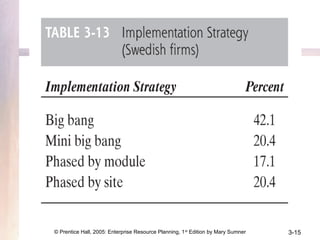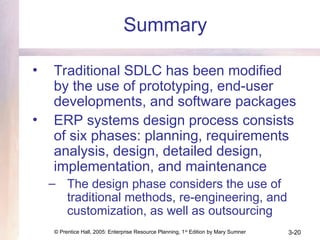Planning, design and implementation of ERP
- 1. © Prentice Hall, 2005: Enterprise Resource Planning, 1st Edition by Mary Sumner 3-1 Enterprise Resource Planning, 1st Edition by Mary Sumner Chapter 3: Planning, Design, and Implementation of Enterprise Resource Planning Systems
- 2. © Prentice Hall, 2005: Enterprise Resource Planning, 1st Edition by Mary Sumner 3-2 Objective • Understand the information systems development process for enterprise systems, including planning, design, and implementation
- 3. © Prentice Hall, 2005: Enterprise Resource Planning, 1st Edition by Mary Sumner 3-3 Traditional Systems Development Life Cycle • Detailed analysis of system using tools and techniques to determine problem areas – Process models – Data models • Phases – Problem definition – Feasibility study – Systems analysis – Systems design – Detailed design – Implementation – Maintenance
- 4. © Prentice Hall, 2005: Enterprise Resource Planning, 1st Edition by Mary Sumner 3-4
- 5. © Prentice Hall, 2005: Enterprise Resource Planning, 1st Edition by Mary Sumner 3-5 Traditional Systems Development Life Cycle, continued • Automating current system is counter- productive – Inherit old problems and flaws • Provides opportunity to re-engineer current system • Create logical database design before details are refined • Takes too much time • Uses a great deal of resources • Expensive
- 6. © Prentice Hall, 2005: Enterprise Resource Planning, 1st Edition by Mary Sumner 3-6 New Approaches • Prototyping – Models shown to end-users for feedback, guidance – Not necessarily faster • End-user development – End-users create information systems using spreadsheets and databases – Not effective for large-scale development • Software packages – Economies of scale in development, enhancement, maintenance
- 7. © Prentice Hall, 2005: Enterprise Resource Planning, 1st Edition by Mary Sumner 3-7 ERP Systems Design Process • Phases – Planning – Requirements analysis – Design – Detailed design – Implementation – Maintenance
- 8. © Prentice Hall, 2005: Enterprise Resource Planning, 1st Edition by Mary Sumner 3-8 Planning and Requirements Phases – Planning • Needs assessment • Business justification – Tangible and intangible benefits – Requirements analysis • Identify business processes to be supported • “Best practices” offered by vendors – Models of supported functions • Checklist of activities and factors
- 9. © Prentice Hall, 2005: Enterprise Resource Planning, 1st Edition by Mary Sumner 3-9 Design Phase • Re-engineering business processes to fit software – Traditional SDLC defines new business requirements and implements conforming software • Re-engineering versus customization – Re-engineering can disrupt organization • Changes in workflow, procedures – Customizing • Upgrading can be difficult
- 10. © Prentice Hall, 2005: Enterprise Resource Planning, 1st Edition by Mary Sumner 3-10 Alternative Designs • “Vanilla” – Easy to implement • Follow vendor prescribed methodology • Employ consultants with specialized vendor expertise – Usually on time and on budget implementations • Customized – Time and costs increase – Not easily integrated into new version
- 11. © Prentice Hall, 2005: Enterprise Resource Planning, 1st Edition by Mary Sumner 3-11
- 12. © Prentice Hall, 2005: Enterprise Resource Planning, 1st Edition by Mary Sumner 3-12 Alternative Designs, continued • Maintain legacy systems and add ERP modules – Support specific functions – Cost-effective – Organization doesn’t get full benefit of ERP – Less disruptive – Lacks integration • Outsourcing – External vendor operates • ASPs provide on time-sharing basis • Depends on reliability and stability of vendor
- 13. © Prentice Hall, 2005: Enterprise Resource Planning, 1st Edition by Mary Sumner 3-13
- 14. © Prentice Hall, 2005: Enterprise Resource Planning, 1st Edition by Mary Sumner 3-14 Detailed Design Phase • Team selects the models, processes, and information to be supported – “Best practices” methodology provides models • Select applicable business processes • Discard inapplicable processes • Those processes that do not match the system will serve as foundation for re-engineering • Identify any areas not covered as candidates for customization • Interactive prototyping • Extensive user involvement
- 15. © Prentice Hall, 2005: Enterprise Resource Planning, 1st Edition by Mary Sumner 3-15
- 16. © Prentice Hall, 2005: Enterprise Resource Planning, 1st Edition by Mary Sumner 3-16 Implementation Phase • Implementation – Address configuration issues • Data ownership and management • Security issues – Migrate data • Ensure accuracy – Build interfaces – Documentation review – User training – Reporting – Testing
- 17. © Prentice Hall, 2005: Enterprise Resource Planning, 1st Edition by Mary Sumner 3-17 Implementation Strategies • Big bang – Cutover approach • Rapid • Requires many resources • Small firms can employ • Mini big bang – Partial vendor implementation • Phased by module – Module-by-module – Good for large projects • Phased by site – Location-based implementation
- 18. © Prentice Hall, 2005: Enterprise Resource Planning, 1st Edition by Mary Sumner 3-18 Case: Response to Request for Proposal for an ERP System • Wingate Electric – Mid-sized manufacturer of electric motors – Owned by Dick, CEO, and Steve, COO • MIS system – Supports major accounting and financial functions • Sales order processing, inventory control, accounts payable, accounts receivable, general ledger – Multiple legacy systems • Redundant data • Inconsistent data • Queries difficult
- 19. © Prentice Hall, 2005: Enterprise Resource Planning, 1st Edition by Mary Sumner 3-19 Case: Response to Request for Proposal for an ERP System, continued • Competitors adopting ERP systems – Integrating financial and manufacturing – Web-based front ends • Order processing, tracking, follow-up • RFP for ERP system – Initially to support accounting, financials – Additional support for production, manufacturing – Eventual support for sales and marketing, HR, CRM, eBusiness – $1,000,000 budget for system – Determination made by five executives, representing different user groups • 10 scored criteria • Vendor presentations, supplemental materials
- 20. © Prentice Hall, 2005: Enterprise Resource Planning, 1st Edition by Mary Sumner 3-20 Summary • Traditional SDLC has been modified by the use of prototyping, end-user developments, and software packages • ERP systems design process consists of six phases: planning, requirements analysis, design, detailed design, implementation, and maintenance – The design phase considers the use of traditional methods, re-engineering, and customization, as well as outsourcing



















